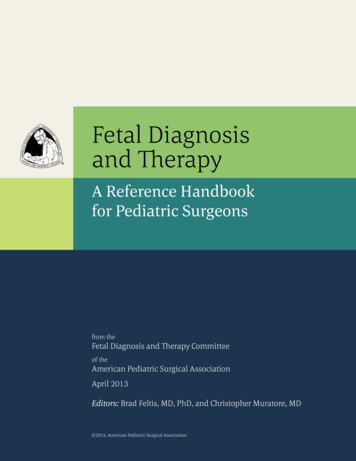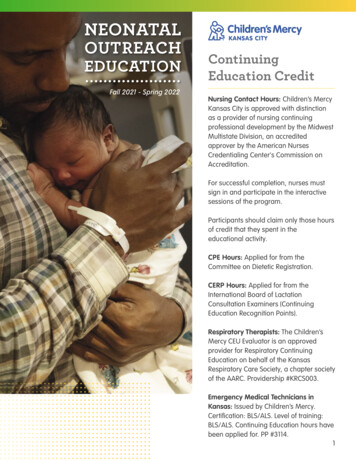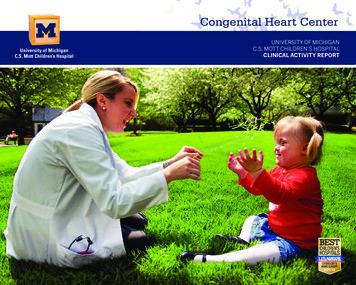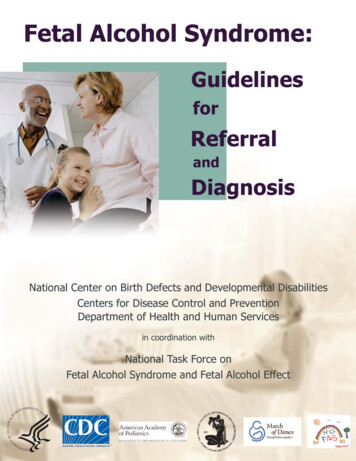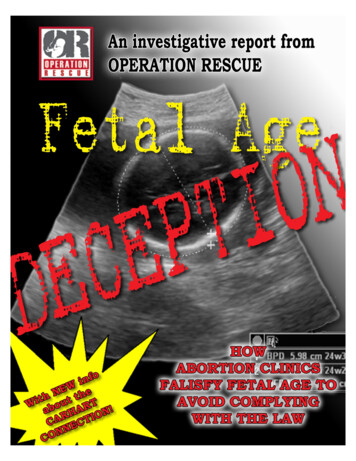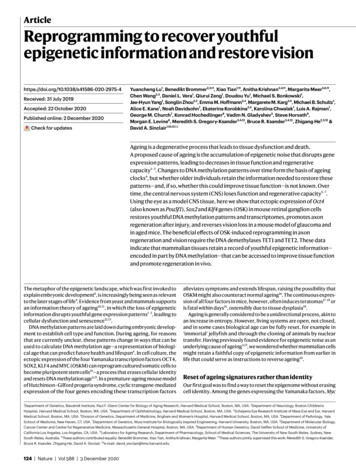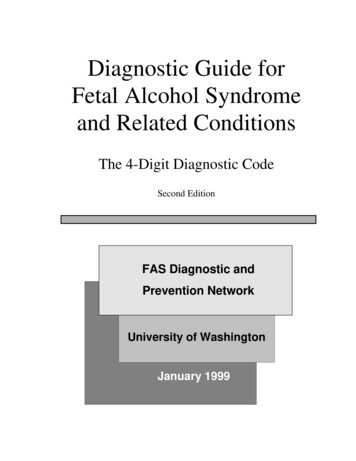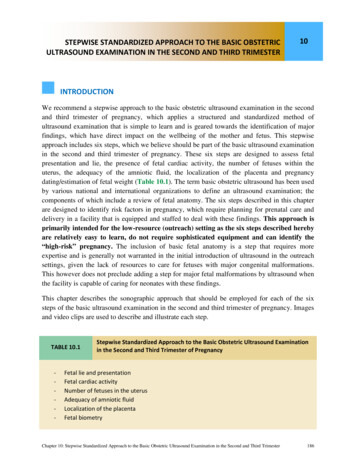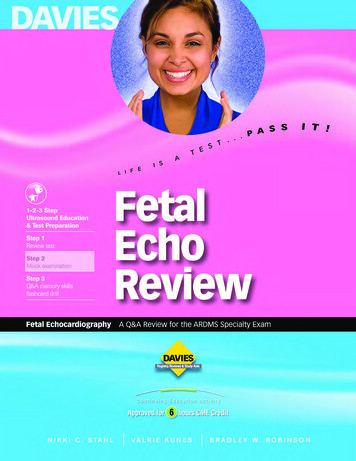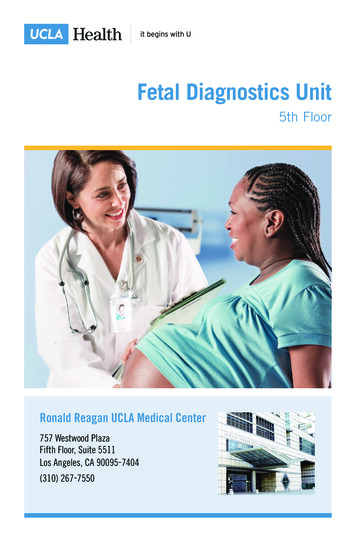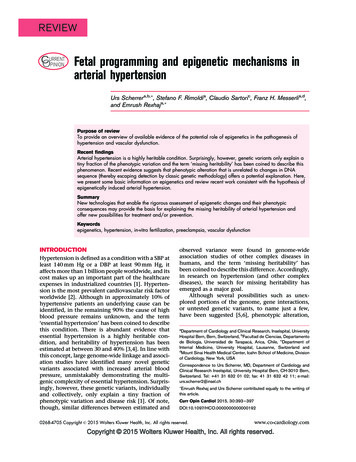
Transcription
REVIEWURRENTCOPINIONFetal programming and epigenetic mechanisms inarterial hypertensionUrs Scherrer a,b, , Stefano F. Rimoldi a, Claudio Sartori c, Franz H. Messerli a,d,and Emrush Rexhaj a, Purpose of reviewTo provide an overview of available evidence of the potential role of epigenetics in the pathogenesis ofhypertension and vascular dysfunction.Recent findingsArterial hypertension is a highly heritable condition. Surprisingly, however, genetic variants only explain atiny fraction of the phenotypic variation and the term ‘missing heritability’ has been coined to describe thisphenomenon. Recent evidence suggests that phenotypic alteration that is unrelated to changes in DNAsequence (thereby escaping detection by classic genetic methodology) offers a potential explanation. Here,we present some basic information on epigenetics and review recent work consistent with the hypothesis ofepigenetically induced arterial hypertension.SummaryNew technologies that enable the rigorous assessment of epigenetic changes and their phenotypicconsequences may provide the basis for explaining the missing heritability of arterial hypertension andoffer new possibilities for treatment and/or prevention.Keywordsepigenetics, hypertension, in-vitro fertilization, preeclampsia, vascular dysfunctionINTRODUCTIONHypertension is defined as a condition with a SBP atleast 140 mm Hg or a DBP at least 90 mm Hg, itaffects more than 1 billion people worldwide, and itscost makes up an important part of the healthcareexpenses in industrialized countries [1]. Hypertension is the most prevalent cardiovascular risk factorworldwide [2]. Although in approximately 10% ofhypertensive patients an underlying cause can beidentified, in the remaining 90% the cause of highblood pressure remains unknown, and the term‘essential hypertension’ has been coined to describethis condition. There is abundant evidence thatessential hypertension is a highly heritable condition, and heritability of hypertension has beenestimated at between 30 and 40% [3,4]. In line withthis concept, large genome-wide linkage and association studies have identified many novel geneticvariants associated with increased arterial bloodpressure, unmistakably demonstrating the multigenic complexity of essential hypertension. Surprisingly, however, these genetic variants, individuallyand collectively, only explain a tiny fraction ofphenotypic variation and disease risk [1]. Of note,though, similar differences between estimated andobserved variance were found in genome-wideassociation studies of other complex diseases inhumans, and the term ‘missing heritability’ hasbeen coined to describe this difference. Accordingly,in research on hypertension (and other complexdiseases), the search for missing heritability hasemerged as a major goal.Although several possibilities such as unexplored portions of the genome, gene interactions,or untested genetic variants, to name just a few,have been suggested [5,6], phenotypic alteration,aDepartment of Cardiology and Clinical Research, Inselspital, UniversityHospital Bern, Bern, Switzerland, bFacultad de Ciencias, Departamentode Biologı́a, Universidad de Tarapacá, Arica, Chile, cDepartment ofInternal Medicine, University Hospital, Lausanne, Switzerland anddMount Sinai Health Medical Center, Icahn School of Medicine, Divisionof Cardiology, New York, USACorrespondence to Urs Scherrer, MD, Department of Cardiology andClinical Research Inselspital, University Hospital Bern, CH-3010 Bern,Switzerland. Tel: 41 31 632 01 02; fax: 41 31 632 42 11; e-mail:urs.scherrer2@insel.ch Emrush Rexhaj and Urs Scherrer contributed equally to the writing ofthis article.Curr Opin Cardiol 2015, 705 Copyright ß 2015 Wolters Kluwer Health, Inc. All rights reserved.www.co-cardiology.comCopyright 2015 Wolters Kluwer Health, Inc. All rights reserved.
HypertensionKEY POINTS Although a highly heritable trait, the pathogenesis ofessential hypertension is poorly understood. Genetic variants account for only a small proportion ofblood pressure variation. The concept of missed heritability is defined as thedifference between estimated and observed variance. Fetal programming and epigenetic alterations mayimportantly contribute to explain this phenomenon.which is unrelated to changes in DNA sequence andthereby is not detected using classic genetic methodology, offers an attractive hypothesis. In line withthis hypothesis, there is emerging evidence demonstrating epigenetic alteration of genes affectingimportant pathways in blood pressure regulation[7,8] that, if heritable, could provide the scientificbasis explaining part of the missing heritability inessential hypertension. Here, we will briefly presentsome basic information on epigenetics and thenreview recent studies in experimental animalmodels and humans consistent with the conceptof epigenetically induced arterial hypertension.FETAL PROGRAMMING OF ADULTDISEASE HYPOTHESISEpidemiological data suggest that environmentalfactors acting during the fetal and perinatal periodalter the regulation of cardiovascular and metabolichomeostasis, which predisposes to cardiovascularand/or metabolic disease later in life. These observations have led to the so-called ‘fetal programmingof adult disease hypothesis’ or ‘Barker hypothesis’[9]. This hypothesis suggests that pathologicalevents during embryonic, fetal, and early postnatallife have persistent effects on cardiovascular andmetabolic homeostasis, and thereby increase therisk for cardiovascular disease and diabetes later inlife (Fig. 1). Although most evidence for fetal programming stems from epidemiological studies inhumans and experimental work in mammals, thereis also evidence for fetal programming and its intergenerational transmission in lower organisms, suchas the fruit fly Drosophila melanogaster [10]. Forexample, in humans, maternal malnutrition duringearly gestation (Dutch famine studies) increases theprevalence of coronary heart disease in the offspring[11]. In line with these observations in humans,maternal diet restriction during pregnancy inrodents, an experimental model mimicking preeclampsia in humans, induces systemic and pulmonary hypertension in the offspring, whichappears to be related to an epigenetic mechanism[8,12].EPIGENETICSEpigenetics is defined as the transmission of geneexpression patterns from one cell generation to thenext, which do not rely on differences in DNAsequence. There exist many examples of cell functions (e.g., tissue specificity, X-chromatin inactivation, germline specificity) that are criticallydependent on epigenetic control of gene expression.Technological progress that allows epigenetic profiling across the genome has allowed documenting inexperimental animals that epigenetic modificationstake place not only during early development butalso later in life [13,14]. The term ‘epigenetics’ refersto chromatin-based mechanisms that regulate geneexpression without affecting the DNA sequence perse. Although epigenetic changes may take placethroughout life, the most important epigeneticmodifications take place during embryonic, fetal,and early postnatal development. These epigeneticEpigenetic mechanismsBirthPrenatalPreeclampsiaIn-vitro fertilizationMaternal nutritionPrenatal lifePerinatalPerinatal hypoxiaChildhoodMalnutritionInflammationPoor weight gainEarly childhoodAdult healthrisk factorsHypertensionVascular dysfunctionObesityInsulin resistanceAdult healthoutcomesCardiovascular diseasesType 2 diabetesAdult lifeFIGURE 1. Fetal programming of arterial hypertension. Schematic representation of the effects of environmental factorsoccurring during early development on cardiovascular diseases later in life. The main putative prenatal, perinatal, andchildhood factors that may lead to epigenetic modifications and in turn influence adult health outcomes are represented.394www.co-cardiology.comVolume 30 Number 4 July 2015Copyright 2015 Wolters Kluwer Health, Inc. All rights reserved.
Fetal programming and epigenetic mechanisms in arterial hypertension Scherrer et al.mechanisms are essential for the adequate regulation of gene expression during these different phasesof early life. The important activity of the epigenome during early life also renders it particularlyvulnerable. In line with this concept, there isincreasing data indicating that during early life,epigenetic mechanisms are strongly influenced bythe environment [15 ] and that environmentallyinduced epigenetic modifications are heritablethroughout generations. The latter is related tothe fact that epigenetic changes not only affectthe phenotype of the immediate offspring, but,because some of these changes are not erased duringgametogenesis, also affect the phenotype and healthof future generations. It is remarkable that epigenetic inheritance of premature vascular ageing andarterial hypertension in mice generated by in-vitrofertilization appears as strong as conventionalgenetic effects observed in knockout animal models[8].The best-studied epigenetic mechanismsinvolve DNA methylation and histone modifications (acetylation and deacetylation; Fig. 2). Othermechanisms, such as micro-RNAs, have also beendescribed [1].&ROLE OF EPIGENETICS IN HYPERTENSIONArterial hypertension and premature vascularageing induced by in-vitro fertilizationAssisted reproductive technologies (ART), whichinitially were developed to treat women with tubaldisease, have been applied to an ever expanding listof other situations, resulting in an exponentialgrowth of the number of babies born by thisprocedure, who now account for 2–5% of birthsin developed countries [16]. Based on emerging datashowing that the early embryo is particularly sensitive to environmental insults, we speculated thatART alters cardiovascular function in the offspring.In line with this speculation, we found that young,apparently healthy ART children display signs ofpremature vascular ageing of the systemic circulation together with pulmonary vascular dysfunctionpredisposing to exaggerated hypoxic pulmonaryhypertension [17–20]. Most importantly, recentdata indicate that ART-induced vascular dysfunction translates into increased arterial blood pressure.Ceelen et al. [21] reported higher systolic and diastolic office blood pressure in ART children than inspontaneously conceived control children, and preliminary data using 24-h ambulatory blood pressuremeasurements show that in ART children, vasculardysfunction is associated with increased SBP andDBP compared with control children [22]. Thesedifferences in blood pressure between ART and control children are clinically important, as childhoodblood pressure tracks into later life [23]. Parenthetically, it is well known that arterial hypertension isoften associated with insulin resistance [24], anddefective nitric oxide-dependent insulin stimulation of blood flow and substrate delivery toskeletal muscle tissue, which leads to insulin resistance in experimental animal models and humans,may represent an underlying mechanism [20,25,26].Normal transcriptionRNA polymeraseFetal insultHistoneDNA methylationhistone nhibition of transcriptionFIGURE 2. Epigenetic mechanisms of gene regulation. Fetal/perinatal insults induce epigenetic alterations, such as DNAmethylation and histone deacetylation, that modify gene expression. DNA methylation occurs at cytosine-phosphatidyl-guanine(CpG) dinucleotides and is responsible for inhibition of transcription. Hyperacetylation of the histones correlates withtranscriptional activation, whereas deacetylation is associated with transcriptional inactivation. Epigenetic alterations can bereversed by pharmacological agents, such as histone deacetylase inhibitors.0268-4705 Copyright ß 2015 Wolters Kluwer Health, Inc. All rights reserved.www.co-cardiology.comCopyright 2015 Wolters Kluwer Health, Inc. All rights reserved.395
HypertensionAccordingly, a recent study demonstrated insulinresistance in young adults conceived by ART [27],suggesting that ART-induced vascular dysfunctionmay facilitate diabetes later in life.Epigenetic mechanisms contribute toassisted reproductive technologies-inducedarterial hypertension and prematurevascular ageingConsistently with observations in humans, ARTinduces arterial hypertension and premature vascular ageing in mice [8,28 ]. Most importantly, observations in ART mice provide direct evidence for theimportance of ART-induced epigenetic alterationsunderpinning the cardiovascular alterations. Theevidence is as follows. In ART mice, the methylationof the promoter of the gene coding for endothelialnitric oxide synthase (eNOS) is altered in the aorta.These epigenetic alterations in the vasculature haveimportant consequences, as shown by decreasedvascular eNOS and eNOS mRNA expression andlower nitric oxide plasma concentration in ARTthan in control mice [29]. The functional importance of these epigenetic alterations is further demonstrated by the effects of histone deacetylaseinhibitor administration to ART mice. These drugshave been shown to reverse epigenetic and phenotypic changes induced by pathologic events duringearly life and to prevent transmission of thesechanges to the progeny [29,30]. Consistently withthese observations, butyrate administration to adultmale ART mice normalizes the methylation andexpression of the eNOS gene in vascular tissuetogether with vascular responsiveness to acetylcholine and prevents the transmission of these alterations to the progeny [29,30].Collectively, these findings indicate that inmice, ART alters the cardiovascular phenotype byan epigenetic mechanism, which changes the entirechain of events starting from altered eNOS methylation in the vasculature over endothelial dysfunction and premature vascular senescence to arterialhypertension and possibly premature mortality [29].It is tempting to speculate that ART-induced epigenetic alterations also play a role in ART-inducedpremature vascular ageing and arterial hypertensionin humans.&Arterial hypertension and premature vascularageing in offspring of preeclampsiaPreeclampsia is characterized by hypertension,proteinuria, and edema, and complicates up to10% of pregnancies in Western countries. Recentdata in young, apparently healthy offspring of396www.co-cardiology.compreeclampsia demonstrate premature vascular ageing of the systemic circulation and exaggeratedhypoxic pulmonary vasoconstriction that arerelated to preeclampsia per se rather than to a geneticabnormality that predisposes the mother to preeclampsia and the offspring to vascular dysfunction[31,32]. These vascular alterations are clinicallyimportant, because they are associated with amarked increase of the risk for stroke later in life[33].Epigenetic mechanism. To test for underlyingmechanisms, we studied offspring of restrictive dietpregnancy (RDP) in mice, a mouse model mimicking several aspects of preeclampsia in humans [34].We found that in addition to systemic vasculardysfunction and arterial hypertension [22], endothelium-dependent pulmonary artery vasodilationin vitro was impaired, and hypoxia-induced pulmonary hypertension and right ventricular hypertrophyin vivo were exaggerated in offspring of RDPcompared with control mice. Most importantly,pulmonary vascular dysfunction was associatedwith altered lung DNA methylation. Administrationof histone deacetylase inhibitors to offspring ofRDP normalized pulmonary DNA methylation andpulmonary vascular function, demonstrating theimportance of epigenetic alterations in causingvascular dysfunction in this model. We speculatethat epigenetic alterations also underpin vasculardysfunction in offspring of preeclampsia in humans.CONCLUSIONEssential hypertension still remains poorly understood. Hypertension is a highly heritable trait, butdiscovered genetic variants account for only a verysmall fraction of phenotypic variation. Missing heritability, which is the difference between estimatedand observed variance, has become a major goal forresearch on hypertension. Here we provide evidencethat epigenetic alterations may contribute importantly to this problem. New technologies that enable the rigorous assessment of epigenetic changesand its phenotypic consequences may providethe basis for explaining the missing heritability ofarterial hypertension and offer new possibilities fortreatment and/or prevention.AcknowledgementsNone.Financial support and sponsorshipThis work was supported by the Swiss National ScienceFoundation, the Swiss Society of Hypertension, the SwissSociety of Cardiology, and the Placide Nicod Foundation.Volume 30 Number 4 July 2015Copyright 2015 Wolters Kluwer Health, Inc. All rights reserved.
Fetal programming and epigenetic mechanisms in arterial hypertension Scherrer et al.Conflicts of interestThere are no conflicts of interest.REFERENCES AND RECOMMENDEDREADINGPapers of particular interest, published within the annual period of review, havebeen highlighted as:&of special interest&& of outstanding interest1. Cowley AW Jr, Nadeau JH, Baccarelli A, et al. Report of the National Heart,Lung, and Blood Institute Working Group on epigenetics and hypertension.Hypertension 2012; 59:899–905.2. Stephan S, Lim EA. A comparative risk assessment of burden of disease andinjury attributable to 67 risk factors and risk factor clusters in 21 regions,1990–2010: a systematic analysis for the Global Burden of Disease Study.Lancet 2012; 380:2224–2260.3. Frazer KA, Murray SS, Schork NJ, Topol EJ. Human genetic variation and itscontribution to complex traits. Nat Rev Genet 2009; 10:241–251.4. Havlik RJ, Garrison RJ, Feinleib M, et al. Blood pressure aggregation infamilies. Am J Epidemiol 1979; 110:304–312.5. Manolio TA, Collins FS, Cox NJ, et al. Finding the missing heritability ofcomplex diseases. Nature 2009; 461:747–753.6. Zuk O, Hechter E, Sunyaev SR, Lander ES. The mystery of missing heritability:genetic interactions create phantom heritability. Proc Natl Acad Sci U S A2012; 109:1193–1198.7. Millis RM. Epigenetics and hypertension. Curr Hypertens Rep 2011; 13:21–28.8. Rexhaj E, Paoloni-Giacobino A, Rimoldi SF, et al. Mice generated by in vitrofertilization exhibit vascular dysfunction and shortened life span. J Clin Invest2013; 123:5052–5060.9. Barker DJ. The fetal and infant origins of disease. Eur J Clin Invest 1995;25:457–463.10. Ost A, Lempradl A, Casas E, et al. Paternal diet defines offspring chromatinstate and intergenerational obesity. Cell 2014; 159:1352–1364.11. Roseboom TJ, van der Meulen JH, Osmond C, et al. Coronary heart diseaseafter prenatal exposure to the Dutch famine. Heart 2000; 84:595–598.12. Van Abeelen AF, Veenendaal MV, Painter RC, et al. The fetal origins ofhypertension: a systematic review and meta-analysis of the evidence fromanimal experiments of maternal undernutrition. J Hypertens 2012; 30:2255–2267.13. Baccarelli A, Rienstra M, Benjamin EJ. Cardiovascular epigenetics: basicconcepts and results from animal and human studies. Circ Cardiovasc Genet2010; 3:567–573.14. Yazbek SN, Spiezio SH, Nadeau JH, Buchner DA. Ancestral paternal genotype controls body weight and food intake for multiple generations. Hum MolGenet 2010; 19:4134–4144.15. Lane M, Robker RL, Robertson SA. Parenting from before conception.&Science 2014; 345:756–760.This review points out the importance of epigenetics as one of the most relevantmechanisms involved in fetal programming of adult diseases.16. Kamphuis E, van Wely M, Repping S, et al. Should the individual preterm birthrisk be incorporated into the embryo transfer policy in in vitro fertilisation? Adecision analysis. BJOG 2015; 122:825–833.17. Rimoldi SF, Sartori C, Rexhaj E, et al. Antioxidants improve vascular function inchildren conceived by assisted reproductive technologies: a randomizeddouble-blind placebo-controlled trial. Eur J Prev Cardiol 2014. [Epub aheadof print]18. Rimoldi SF, Sartori C, Rexhaj E, et al. Vascular dysfunction in childrenconceived by assisted reproductive technologies: underlying mechanismsand future implications. Swiss Med Wkly 2014; 144:w13973.19. Scherrer U, Rimoldi SF, Rexhaj E, et al. Systemic and pulmonary vasculardysfunction in children conceived by assisted reproductive technologies.Circulation 2012; 125:1890–1896.20. Von Arx R, Allemann Y, Sartori C, et al. Right ventricular dysfunction in childrenand adolescents conceived by assisted reproductive technologies. J ApplPhysiol . (in press) doi:10.1152/japplphysiol.00533.2014.21. Ceelen M, van Weissenbruch MM, Vermeiden JP, et al. Cardiometabolicdifferences in children born after in vitro fertilization: follow-up study. J ClinEndocrinol Metab 2008; 93:1682–1688.22. Rexhaj E, Von Arx R, Cerny D, et al. Assisted reproductive technologiesinduced premature vascular ageing persists and evolves into arterial hypertension in adolescents. FASEB J 2015; 29:957.9.23. Chen X, Wang Y. Tracking of blood pressure from childhood to adulthood:a systematic review and meta-regression analysis. Circulation 2008; 117:3171–3180.24. Ferrannini E, Buzzigoli G, Bonadonna R, et al. Insulin resistance in essentialhypertension. N Engl J Med 1987; 317:350–357.25. Cook S, Scherrer U. Insulin resistance, a new target for nitric oxide-deliverydrugs. Fundam Clin Pharmacol 2002; 16:441–453.26. Scherrer U, Randin D, Vollenweider P, et al. Nitric oxide release accounts forinsulin’s vascular effects in humans. J Clin Invest 1994; 94:2511–2515.27. Scherrer U, Sartori C. Insulin as a vascular and sympathoexcitatory hormone:implications for blood pressure regulation, insulin sensitivity, and cardiovascular morbidity. Circulation 1997; 96:4104–4113.28. Scherrer U, Rexhaj E, Allemann Y, et al. Cardiovascular dysfunction in children&conceived by assisted reproductive technologies. Eur Heart J . (in press).This article outlines in a comprehensive manner the most relevant studies in fetalprogramming of premature vascular ageing induced by assisted reproductivetechnologies.29. Lewandowski AJ, Leeson P. Preeclampsia, prematurity and cardiovascularhealth in adult life. Early Human Develop 2014; 90:725–729.30. Langley-Evans SC. Developmental programming of health and disease. ProcNutr Soc 2006; 65:97–105.31. Jayet PY, Rimoldi SF, Stuber T, et al. Pulmonary and systemic vasculardysfunction in young offspring of mothers with preeclampsia. Circulation2010; 122:488–494.32. Lazdam M, de la Horra A, Pitcher A, et al. Elevated blood pressure in offspringborn premature to hypertensive pregnancy: is endothelial dysfunction theunderlying vascular mechanism? Hypertension 2010; 56:159–165.33. Kajantie E, Eriksson JG, Osmond C, et al. Preeclampsia is associated withincreased risk of stroke in the adult offspring: the Helsinki birth cohort study.Stroke 2009; 40:1176–1180.34. Rexhaj E, Bloch J, Jayet PY, et al. Fetal programming of pulmonary vasculardysfunction in mice: role of epigenetic mechanisms. Am J Physiol Heart CircPhysiol 2011; 301:H247–H252.0268-4705 Copyright ß 2015 Wolters Kluwer Health, Inc. All rights reserved.www.co-cardiology.comCopyright 2015 Wolters Kluwer Health, Inc. All rights reserved.397
of the promoter of the gene coding for endothelial nitric oxide synthase (eNOS) is altered in the aorta. These epigenetic alterations in the vasculature have important consequences, as shown by decreased vascular eNOS and eNOS mRNA expression and lower nitric oxide plasma concentration in ART than in control mice [29]. The functional import-

